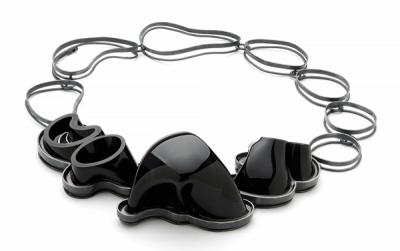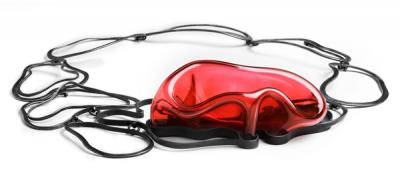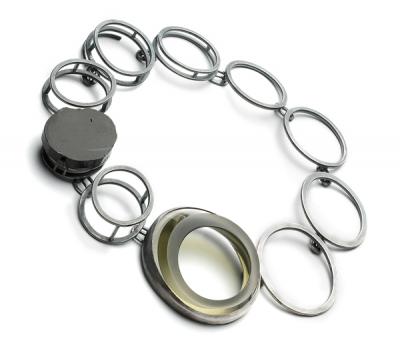
Susan Cummins: In your new show at Sienna Gallery, you seem to have changed your approach to making jewelry. Gone are the twisted expressive wires and in come the cool, sleek glass and metal. What happened?
Biba Schutz: I am continually looking for new challenges and traveling in unchartered areas.
As time has passed … my language and materials have grown, but the voice still has the same thread of inspiration and process. I still investigate, challenge, and explore my environment and emotional experiences. There is still mystery, memory, and a place to hide and travel while experiencing my jewelry.

Susan Cummins: In your new show at Sienna Gallery, you seem to have changed your approach to making jewelry. Gone are the twisted expressive wires and in come the cool, sleek glass and metal. What happened?
Biba Schutz: I am continually looking for new challenges and traveling in unchartered areas.
As time has passed … my language and materials have grown, but the voice still has the same thread of inspiration and process. I still investigate, challenge, and explore my environment and emotional experiences. There is still mystery, memory, and a place to hide and travel while experiencing my jewelry.
I was introduced to the contemporary glass movement when I went to my first Rhinebeck fair with Doug Heller (in the 70s). Over the years I have been continually mesmerized and enthralled by the experience and fluidity of glass. After 20 years of exclusively using metal, I began to feel comfortable expanding my material base. About six years ago, I started thinking about using glass.
It took a while for me to develop a way to use my voice to explore glass and metal. If I did this, it had to read as Biba Schutz.
A past assistant was setting up her own studio. She had been a metal and glass major in college. It was a perfect opportunity to begin experimenting (she understands how I process and is familiar with my nuances). Sienna Patti’s enthusiasm and encouragement have been paramount in this endeavor.
Susan, to me glass is hot, sexual, and alive.

Are you working in both the glass and metal, or is this a collaboration?
Biba Schutz: This jewelry is my vision, not a collaboration. I work with assistants. Working with glass is about a team. I am an assistant and director in the hot shop and am often the assistant or director with lampwork in my studio. Though I know the dance—I can blow a bubble, do lampwork (partially thanks to a month-long artist residency at Corning Glass)—I don’t work alone. My assistants support my passion and are helping me fulfill my dream. I don’t know all the rules, so I can push the process … moving the glass. I am finding my voice in the glass and developing and integrating it into the metal. I have an assistant in my studio who assists with building the metal work as well. Every piece is constructed with relationship to the body, physically and emotionally.

In the contemporary jewelry world, it feels that you are one of the hardest workers, as they used to say about Tina Turner. You seem to do lots of fairs and gallery shows. How do you manage it all? What is your process?
Biba Schutz: Susan, I wish I had legs like Tina’s—thank you!

I could not produce this amount of work on my own—I have two assistants who each work four days a week. My studio is in a commercial building in New York City, walking distance from my apartment.

Biba Schutz: No, being a jeweler sort of came through a journey. I am self-taught as a jeweler.
My earliest recollections were that I was going to be an artist. I was going to live in a garret in Paris, be a painter, and live the bohemian life. As a child, I never colored in the lines, I always wanted to break the rules. I was allowed to draw all over my house as a child, between paint jobs and wallpapering … how great a canvas for a six-year-old. I went to school for fine arts and graphic design.
After college, I worked as a graphic designer. My eye, hand, and problem-solving skills were honed and have been an asset to my process. It was textiles that introduced to my current world of making.
What do you think is the role of jewelry in culture?
Biba Schutz: Jewelry is adornment, and adornment is one of the aspects defining culture and civilization. I think jewelry, just as any of the arts and commerce, is relevant in culture. Truly, time will really tell. Movements mark change … non-movements mark change. The role of jewelry is no different from any art form that shows an artist’s voice and reflects the times.
In reflection, if jewelry can instigate dialogue, emotion, and passion and mark its time, it represents culture.

Biba Schutz: There are many artists that I admire. I will be patriotic and stay with the USA, mostly my friends. To be a little more specific: Lola Brooks, Sondra Sherman, Kiff Slemmons, and Pat Flynn. There are three artists who no longer make jewelry but use a jeweler’s sensibility that I need to mention: Myra Mimlitsch-Gray, Sharon Church, and Lisa Gralnick.
What have you seen, heard, or read that you would like to recommend?
Biba Schutz: I am drawn to theater and performance art that explores the human condition—Shakespeare, Ionesco, Brecht—especially when the performance is contemporized or experimentally presented (these days, what was once experimental very quickly becomes accessible). I am always ready for Martha Clarke and the late Pina Bausch. I just started reading The Rise, by Sarah Lewis.




